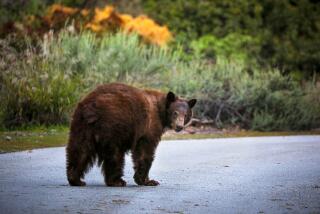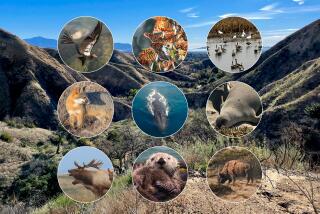First Hints of Spring Fever Creep North
Spring may still be a week away, but spring fever has already reached epidemic proportions south of the border and is working its way north.
âUnusual? Itâs unheard of for this time of year, really,â Jeff DeBuys, skipper of the Red Rooster III, said Wednesday of his encounter two weeks ago with a large school of albacore 340 miles south of his home port in San Diego. âItâs really interesting because [another boat] found some albacore 140 miles below where we found ours, so that makes me think there are a lot of fish in the area.â
Albacore fever usually doesnât set in until June or July, but with fish off Baja California so early, and presumably migrating slowly northward, it may start much sooner this year.
As for the Red Rooster III, it will arrive Saturday morning after a 20-day trip to Hurricane Bank and Clipperton Atoll, where giant yellowfin tuna and slender wahoo were the main attractions.
âWe only caught a handful of albacore on our way down because we had to get a move on,â DeBuys said.
*
Gary Graham of Baja on the Fly, the only major fly-fishing outfit in the East Cape region of southern Baja, gives an honest and informative -- and sometimes even entertaining -- report. This week he was in rare form.
âDorado, tuna and marlin continue to make this what may be one of the best winter bites in quite a while. El Nino? Who knows? Who cares?â Graham wrote. âThe water is definitely warmer, earlier. We are not talking rat dorado, either. Some of these critters are tipping the scale at 25-pounds-plus and look like some kind of psychedelic vacuum cleaners as they sweep in behind the boat eating [sardines].
âAnd, oh yes, they are even being suckered into eating a hook with only fur and feathers on it. Back inshore, the sierra are also getting pretty stupid, regularly taking flies from both the beach and from boats fishing close to shore.... The ladyfish bite both early and late has been spectacular. Cast a Clouser; let it sink, wham and you come tight to a fish with the attitude of a small tarpon.â
*
Then thereâs Jonathan Roldan, a man who obviously has spent too much time in the sun, filing this report from La Paz on behalf of Tail Hunters International in Hacienda Heights, which books trips to the southern Baja region:
âTell ya what, pescadores ... I think Father Winter just blew on past us this year. Iâll keep my fingers crossed and my bananas tucked away [he considers them bad luck, as many fishermen do] cuz thatâs just fine with me!
âI think the jury is in that this is the finest winter fishing weâve ever had as long as Iâve been soaking baits out in the La Paz environs! Yes ... we are still getting some northern chilly-willy winds, but with increasing frequency they seem to be coming from the warmer south and with it ... well ... the critters are coming too!
âThe Las Arenas side of the peninsula from Muertos Bay to the lighthouse is still the battle zone for any number of species from cabrilla to pargo, but most notably the dorado. Doggone if we didnât have some kickers jam the boxes these last few days with some big-headed bull dorado on the chew. Some of these dorado were stud fish too ... like 30-40 pound toads! Seriously, thatâs not supposed to be happening now!â
*
Finally, a gentler tone from the office of Pisces Sportfishing in Cabo San Lucas, where a marlin bite that had been sizzling at an unseasonably feverish pace off Cabo San Lucas settled into something more typical. But only briefly.
âWe started to see a gradual slowdown on March 9 and by March 11, no marlin were caught,â fleet owner Tracy Ehrenberg said. âBoats had headed up to Punta Gorda and Destiladeres as they have daily for the fabulous catches, but all drew a blank. [Wednesday] they decided to go the other way [into the Pacific], which was a good choice as pretty much everybody out had tuna, up to 15, but the norm being around five in the 20- to 25-pound class, plus a few dorado here and there. Also three mako sharks caught this week.â
On Thursday, however, the bite began to sizzle again in the Pacific where one boat registered a catch of nine striped marlin and the average climbed back to two-three per boat.
Big Business
Among claims and comparisons made in a recently-published 2001 National Survey of Fishing, Hunting and Wildlife-Associated Recreation: Sportsmen and women support more jobs nationwide (1.6 million) than the number of people employed by Wal-Mart, the countryâs largest corporation; fishing alone supports more jobs (1 million) than Exxon-Mobil (98,000), General Motors (365,000) and Ford (383,000) combined; five million more Americans fish than golf; each year hunters spend more on food for hunting trips than Americans spend on Dominoâs pizza.
The report was published by the National Shooting Sports Foundation in conjunction with the Congressional Sportsmenâs Foundation and American Sportfishing Assn.
Killer Blockade
These are dangerous times for California gray whales passing through Monterey, en route home to the Bering Sea. Killer whales are aware of the northbound migration and often wait in ambush in Monterey Canyon, hoping to separate mothers from their calves but not always being so picky.
âWe had a few killer whales the other day,â said Nancy Black, a killer whale researcher who also runs general whale-watching trips out of Monterey Bay Whale Watch. âWe think they killed a gray but we didnât see the attack. We only saw them feeding on the whale.â
This kind of activity should pick up in April and May, when mother-and-calf pairs, which are slower to migrate, start passing through. Meanwhile, Black reports sightings of between 20 and 30 grays per day on the three-hour trips.
Meanwhile, in Southern California, the northbound migration of gray whales is starting to peak. Alisa Schulman-Janiger, who heads a gray whale census and behavior project at San Vicente on the Palos Verdes Peninsula, said volunteers through Wednesday had tallied 394 northbound grays, which is about average and well above the same-period count during the last few seasons.
She added that only two northbound mother-calf pairs have been seen so far.
Bass Bites
Mid-season accolades from the CITGO Bassmasters Tour: Heaviest winning weight (20 fish): 73 pounds 5 ounces by Edwin Evers of Mannsville, Oklahoma, at Alabamaâs Lake Eufaula; heaviest bass weighed: 10 pounds 4 ounces by Jay Yelas of Tyler, Texas, at Georgiaâs Lake Seminole; largest one-day catch (five fish): 26 pounds 8 ounces by Mark Sabbides of Pollock, La., at Floridaâs Lake Okeechobee. The tourâs next stop, before a two-event swing through Northern California, is at Santee Cooper Reservoir in Manning, South Carolina.
Australian for Victory
Australiaâs Dean Morrison emerged the winner Sunday of the seasonâs first Assn. of Surfing Professionalsâ World Championship Tour event, the Quiksilver Pro at Snapper in Queensland. Morrison defeated countryman Mark Occhilupo in a final featuring three- to four-foot waves. En route to the final, he triumphed over six-time world champion Kelly Slater (Cocoa Beach, Fla.) and countrymen Jake Paterson and Mick Fanning.
Pat OâConnell of San Clemente was the only non-Australian to advance to the semifinals, where he lost to Occhilupo.
The Roxy Pro, the first womenâs event of the season, was won by an Australian, five-time champion Layne Beachley.
Crowning Moment
Carlsbadâs Shaun White, 16, won both the slopestyle and superpipe competitions last weekend during the Vans North American Championships, third leg of the Vans Triple Crown of Snowboarding at Bear Mountain Resort in Big Bear Lake.
Nate Sheehan of Midvale, Utah, won the overall Triple Crown title. White, the X Games champion who did not compete in the first leg of the Triple Crown, is in Stratton, Vt., this week competing in the Philips U.S. Open Snowboarding Championships.
Casting Calls
The Sierra Pacific Flyfishersâ annual free fly-casting course begins Saturday at 9 a.m. at Reseda High School. The first three four-hour classes are at the school. The final session is at Piru Creek. Details: (818) 888-1974.... The annual spring fly fishing festival at Fishermenâs Spot Flyfishing in Van Nuys is scheduled March 30 from 10 a.m.-4 p.m. It includes gear and travel booths, demo areas and tying demonstrations.
More to Read
Sign up for The Wild
Weâll help you find the best places to hike, bike and run, as well as the perfect silent spots for meditation and yoga.
You may occasionally receive promotional content from the Los Angeles Times.






